无机化学-配位化学基础-配合物的命名
无机化学课件-配位化合物
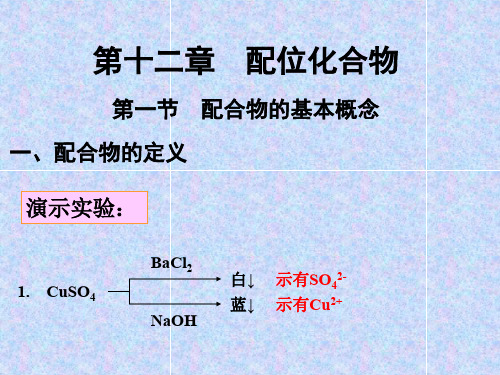
乙二酸根(草酸根):
O
O 2-
CC
OO
六齿配体:乙二胺四乙酸根 EDTA(Y4-)
OOC– H2C
CH2 – COO 4-
N–CH2 –CH2 –N
OOC– H2C
CH2 – COO
3.配位数:
指在配合物中直接与中心原子配合的配位 原子的数目
表示:n 特点:一般是2,4,6,8 (偶数)
单齿配体: [ Cu(NH3)4]2+
{ 3.特殊配合物
簇状配合物
π-酸配体配合物
桥基配合物:
H O (H2O)4 Fe Fe(OH2)4 O H
簇状配合物 :
CO CO CO CO
Fe Fe
CO
CO CO
CO
CO
四、配合物的几何异构现象
几何异构体:组成相同、空间排列方式不同的物质 平面四方形空间构型的[Pt(NH3)2Cl2],就有两
种不同的排列方式:
Cl
NH3
Pt
Cl
NH3
顺式
μ≠0 棕黄色
有抗癌活性
Cl
NH3
Pt
NH3
Cl
Байду номын сангаас
反式
μ=0 亮黄色 无抗癌活性
第二节 配合物的化学键理论
一、价键理论
(一)基本要点:
1.配合物的中心原子与配体之间是以配位键结合的: M ← L。
2.在形成配离子时,中心原子所提供的空轨道必须首 先进行杂化,形成数目相同的新杂化轨道,M以杂化 空轨道接受L提供的电子而形成σ配键。配离子的空间 构型、配位数、稳定性,主要取决于形成配位键时, M所用的杂化轨道的类型。 3.M的原子轨道杂化时,由于参加杂化的轨道能级不 同,形成的配离子可分为内轨型、外轨型。
无机化学第八章 配合物

氯化 一硝基 · 一氨 · 一羟氨基 · 一吡啶合铂 (Ⅱ)
K3[CrCl2(NH2)2(NO2)2] 配离子: [CrCl2(NH2)2 (NO2)2] 3中心离子: Cr3+ 配位体: Cl- NH2- NO2配位原子: Cl N
N
配位数: 6
配离子电荷: -3
中心离子氧化值: + 3
命名: 二氯·二氨基·二硝基合铬(Ⅲ)酸钾
≈1
Mn2+ : 3d5
[Mn(CN)6]4 -: d2sp3 正八面体 内轨型
例2:下列配离子中哪个磁矩最大? [Fe(CN)6]3- [Fe(CN)6]4- [FeF6]3解: n(n 2)
配离子 [Fe(CN)6]3[Fe(CN)6]4[FeF6]3M的d电子数
∴[FeF6]3-磁矩最大
配位数
直接与中心离子配位的配位原子的数目 半径越大,配位数大 半径:
中心离子 电荷越高,配位数越大 电荷:
半径越大,配位数小 半径: 数值
配体
电荷: 电荷越高,配位数越小
浓度: 增大配体浓度
外界条件
温度: 降低反应温度
高配位 数的配 合物
配离子的电荷 =中心离子的电荷+配位体的电荷 [Cu(NH3)4]2+ [HgI4]2[Ni(CO)4] +2 + 0×4 = +2 +2 + (-1)×4 = -2 0 + 0×4 = 0 +3 + (-1)×4 + 0 + 0 = -1
④配位原子相同
配体中原子个数少的在前
(NH3)(NH2OH) ② ①
⑤配体中原子个数相同 按与配位原子直接相连的其他原子的元 素符号英文字母顺序 (NO2-)(NH2-) ② ①
无机化学中的配位化学理论
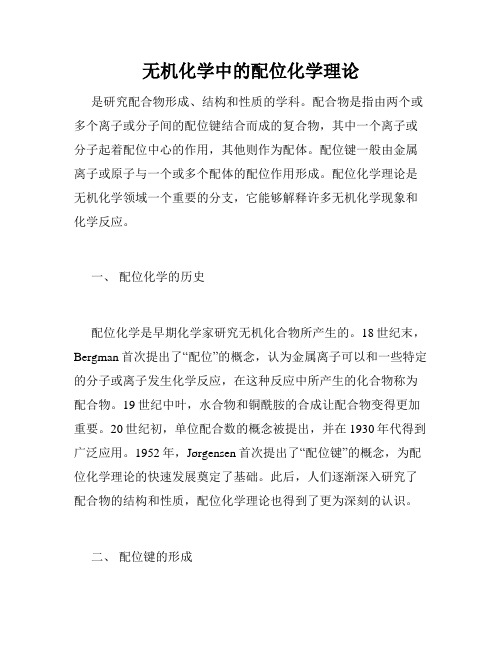
无机化学中的配位化学理论是研究配合物形成、结构和性质的学科。
配合物是指由两个或多个离子或分子间的配位键结合而成的复合物,其中一个离子或分子起着配位中心的作用,其他则作为配体。
配位键一般由金属离子或原子与一个或多个配体的配位作用形成。
配位化学理论是无机化学领域一个重要的分支,它能够解释许多无机化学现象和化学反应。
一、配位化学的历史配位化学是早期化学家研究无机化合物所产生的。
18世纪末,Bergman首次提出了“配位”的概念,认为金属离子可以和一些特定的分子或离子发生化学反应,在这种反应中所产生的化合物称为配合物。
19世纪中叶,水合物和铜酰胺的合成让配合物变得更加重要。
20世纪初,单位配合数的概念被提出,并在1930年代得到广泛应用。
1952年,Jørgensen首次提出了“配位键”的概念,为配位化学理论的快速发展奠定了基础。
此后,人们逐渐深入研究了配合物的结构和性质,配位化学理论也得到了更为深刻的认识。
二、配位键的形成配位化学的核心是配位键的形成。
配位键可以分为共价性和离子性两种。
共价式键通常存在于过渡金属配合物中,它由金属离子的未满足配位电子对与配体的配位电子对相互重叠形成。
而离子式键则通常存在于铜、银和金等含d10电子的金属配合物中,它由金属离子的正电荷和配体的负电荷静电作用形成。
此外,还有一种类似氢键的键,即氢键型配位键,它主要存在于氢氧根、氨、水和羟基等配体中。
三、配位环境的影响配合物的结构和性质取决于配位环境,即最内层的配体、次内层的离子和周围溶剂的影响。
其中,配体的种类、数量和配位位置是影响配合物结构的关键因素。
次内层的离子通过配位作用能够改变配合物的电荷和几何构型。
而溶剂分子也能与金属离子配位形成溶剂合金属离子,并影响配合物的物理化学性质。
此外,温度、压力、电场等外部因素也会影响配合物的性质。
四、配合物的分类配合物可以根据金属离子的性质、配体的性质和功能进行分类。
根据金属离子的性质,配合物可以分为过渡金属配合物、主族金属配合物和内过渡金属配合物。
无机化学大一知识点归纳
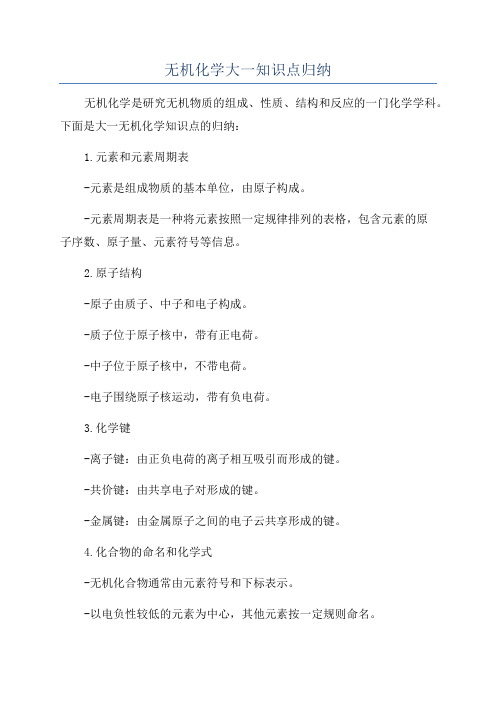
无机化学大一知识点归纳无机化学是研究无机物质的组成、性质、结构和反应的一门化学学科。
下面是大一无机化学知识点的归纳:1.元素和元素周期表-元素是组成物质的基本单位,由原子构成。
-元素周期表是一种将元素按照一定规律排列的表格,包含元素的原子序数、原子量、元素符号等信息。
2.原子结构-原子由质子、中子和电子构成。
-质子位于原子核中,带有正电荷。
-中子位于原子核中,不带电荷。
-电子围绕原子核运动,带有负电荷。
3.化学键-离子键:由正负电荷的离子相互吸引而形成的键。
-共价键:由共享电子对形成的键。
-金属键:由金属原子之间的电子云共享形成的键。
4.化合物的命名和化学式-无机化合物通常由元素符号和下标表示。
-以电负性较低的元素为中心,其他元素按一定规则命名。
-阴离子添加前缀“亚”或“次”。
5.分子、离子和化学平衡-分子是两个或两个以上原子共用电子对形成的物质。
-离子是由失去或获得电子而带电荷的原子或原子团。
-化学平衡是指反应物和生成物在化学反应中达到一定比例的状态。
6.配位化学-配位化学研究由配位子与中心金属离子或原子形成的配合物。
-配位子是一种带有孤对电子的离子或分子,能形成与金属离子配位的化合物。
7.酸碱中和反应-酸是能提供H+离子的物质,碱是能提供OH-离子的物质。
-酸碱反应是指酸和碱在适当条件下生成盐和水的反应。
8.氧化还原反应-氧化是指物质失去电子;还原是指物质获得电子。
-氧化还原反应包括氧化剂和还原剂之间的电子转移。
9.配位数和配位几何-配位数是指配位物与中心离子相结合时的配位键数目。
-配位几何是指配位物形成的平面、三维结构。
10.键合理论-价键理论:电子通过共享方式存在于分子中。
-晶体场理论:金属和配位物的结合由于静电相互作用。
这些知识点是大一无机化学的基础,并为进一步学习无机化学提供了基础。
熟悉这些知识点将有助于理解物质的性质和化学反应的原理。
宋天佑版无机化学 第11章配位化学基础
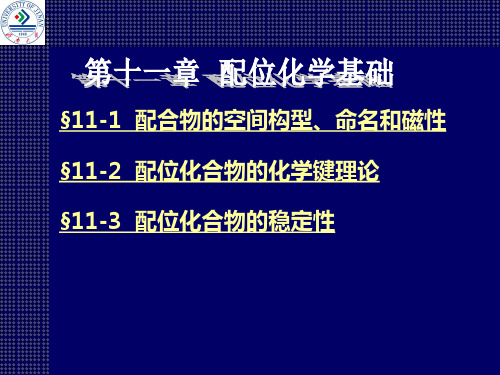
-
F
-
F
-
F
-
F
-
3.内轨型与外轨型配合物
内轨型配合物
中心离子或原子以部分次外层轨道(n-1)d 参与组成杂化轨道,接受配体的孤电子对形成 内轨型配合物。如: d2sp3、dsp2、dsp3等。 特点:由于配体影响,形成体的电子重新 分布,未成对电子数减少。
成对能P:在形成内轨型配合物时,要违反 洪特规则,使原来的成单电子强行在同一d轨道 中配对,在同一轨道中电子配对时所需要的能 量叫做成对能(用P表示)。
11.1.3 配合物的命名
基本遵循一般无机化合物的命名原 则 1.整体命名:先阴离子,后阳离子 配离子为阳离子 外界是简单阴离子(OH-、Cl-), “某化某” [Ag(NH3)2]OH [Pt(NH3)6]Cl4 外界是复杂阴离子,“某酸某”
配离子为阴离子 外界为氢离子 “某酸” H2[PtCl6]
F HCI Br I
配体类型 单齿配体:一个配体中只含一个配位原子 NH3、OH-、X-、CN-、CO、SCN-等 多齿配体:一个配体中含2个或2个以上配位原子 草酸根(C2O42-) -OOC-COO- 双齿 乙二胺(en) NH2-CH2-CH2-NH2 双齿 乙二胺四乙酸根(EDTA或Y) 六齿 P862-863 部分配体名称: 硝基:NO2;亚硝酸根:ONO-;硫氰酸根:SCN-;异 硫氰酸根:NCS-;羰基:CO;羟基:-OH
MA2B2C2—正八面体的异构体。
平面偏振光
当平面偏振光通过某种介质时,有的介质对偏 振光没有作用,即透过介质的偏振光的偏振面 保持不变。而有的介质却能使偏振光的偏振面 发生旋转。这种能旋转偏振光的偏振面的性质 叫做旋光性。具有旋光性的物质叫做旋光性物 质或光活性物质。
《无机化学》第8章

钴(Ⅲ)
Co3+ NH3 N 6
+2
溴化二(乙二胺)
④[Cu(en)2]Br2 合铜(Ⅱ) Cu2+ en N 4 +2
二、2、
① 六氯合铂(Ⅳ)酸 ② 硫酸四氨合铜(Ⅱ) ③ 四硫氰·二氨合钴(Ⅲ)酸铵 ④ 五羰基合铁 ⑤ 二氢氧化四氨合铜(Ⅱ) ⑥ 一氯化二氯·一水·三氨合钴(Ⅲ)
习题:
一、选择题。
(2)形成体:(中心离子或中心原子)
接受孤对电子的阳离子或原子 ①特点:具有接受孤对电子的空轨道 ②常见中心原子:过渡元素(特别是ⅧB族)
或具有高氧化态的P区非金属元素
③举例:
形成体 (中心离子或中心原子)
[Cu(NH3)4]2+ [Fe(CN)6]3[PtCl2(NH3)I2] [Fe(CO)5] [SiF6]2-
Cu2+ Fe3+ Pt4+ Fe原子 Si4+
(3)配位体和配位原子:
①配位体:(配体) 在配合物中,与中心离子(或原子)
相结合的分子或离子,称为配位体,简 称配体。 例如:
[Cu(NH3)4]SO4 配体: NH3
②配位原子: 在配体中,与中心离子(或原子)
相结合的原子,称为配位原子。
❀常见配位原子:X、O、S、N、C
一、指出下列配合物的配位原子和配位数:
配合物
[PtCl2(NH3)2]2+ [Fe(en)3] 3+ [Ag(NH3) 2] [Pt (NH3)6] 4+ [Cr Cl2 (en)2] 2+
配位原子 Cl、N
N N N Cl、N
配1、配合物的内界和外界以_离__子__键相结合。 2、配合物的配体和中心离子(或原子)以
配合物的中文命名法

2.2 镜像异构(旋光异构)
2.2.1 镜像异构
当两种化合物的组成 和相对位置皆相同, 但它们互为镜像关系, 象左右手一样不能重 合,这种异构称为手 性异构或镜像异构。 如丙氨酸,等。
2.3 结构异构
如何通过实
2.3.1电离异构(离子异构) 验区分?
配合物中具有相同的分子式但不同的配位阴离子(因 而水溶液中产生不同的离子)的配位化合物。如 [Co(NH3)5Br]SO4和[Co(NH3)5SO4]Br。
•
[Co(NH3)5H2O]Cl3 三氯化五氨·一水合钴(III)
④若同类配体的配位原子相同,则含较少原子数的配体排
在前
[Pt(NO2)(NH3)(NH2OH)(Py)]Cl 氯化硝基·氨·羟氨·吡啶合铂(II)
⑤若配位原子相同,配体中所含原子数目也相同, 则按在结构式中与配位原子相连的原子的元素符号 字母顺序排列
普鲁士军队
德皇威廉一世在凡尔赛宫镜厅加冕 军服多为 普鲁士蓝
普鲁士蓝在医学上的应用
铊可置换普鲁士蓝上的钾后形成不溶性物质,使其随粪便排出,对治疗经口急慢性 铊中毒有一定疗效。
1994年12月,1995年3月,清华大学92级化学系物理化学和仪器分析专业2班学生 朱令中铊毒,生命危急,后被医院用普鲁士蓝救活。
若外界为OH-离子,则称氢氧化某;
[Cu(NH3)4](OH)2
氢氧化四氨合铜
配合物内界
按下列顺序依次命名:
配位体数→配体名称→合→中心离子(氧化数)
Cu(NH3)42+ [Mn(H2O)6]2+
四氨合铜(II)离子 六水合锰(II)离子
①配体名称置于中心原子之前
例1:[Fe(CN)6]4-
配位化学第2章-基础
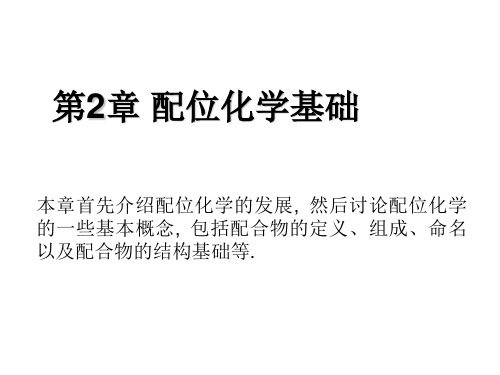
硫酸铜和水都是独立存在的稳定化合物, 它们仍然可以相互作 用, 形成更复杂的化合物五水硫酸铜. 由于人们在相当长的一段 时间内并不能了解式3−1中两个反应物的作用机理, 尽管得到的 产物组成易于确定, 但其结构并不清楚, 因此, 早期将这类化合 物统称为复杂化合物, 汉语译为络合物. 1798年, 法国化学家塔舍特(Tassert)将蓝色的二氯化钴与氨 作用, 得到了玫瑰红色的化合物, 其组成为CoCl2∙6NH3, 该物质 在有氨和氯化铵存在下, 于水溶液中慢慢转变为桔黄色, 分析产 物的组成为CoCl3∙6NH3, 很明显, 它是由CoCl2∙6NH3氧化而产 生的, 见式3−2.
早在上世纪五十年代就已成立的国际性配位化学 学会, 至今已举办数十次国际配位化学会议(ICCC), 其中第25届就是于1987年7月在中国南京举行, 由 南京大学配位化学研究所承办, 我国化学界前辈戴 安邦院士担任大会主席, 著名无机化学家游效曾院 士担任大会秘书长.
据统计目前有关配位化学研究的原始论文占无 机化学专业论文总数的75%以上。 随着现代物质结构理论以及现代物理技术的推 动, 配位化学的研究成果已远远超出了无机化学 的范畴, 已经渗透到化学的所有分支领域, 包括 分析化学、有机化学、物理化学、高分子化学、 结构化学、环境化学、催化机理、生物化学、 以及能源、原子能、激光、半导体、空间科学 等众多科技领域.
CoCl2 (蓝色) + 6NH3 → CoCl2∙6NH3 (玫瑰红色) → CoCl3∙6NH3 (桔黄色) 3−2
上述研究可认为是配位化学的起点, 这是因为塔舍特的报道 在当时便引起轰动, 很多无机化学家对这类奇异的化学反应 性产生了浓厚兴趣. 从那时起, 经过一百五十年的发展, 到上 世纪中叶, 配位化学已发展成为化学学科中一门及其重要的 分支学科.
- 1、下载文档前请自行甄别文档内容的完整性,平台不提供额外的编辑、内容补充、找答案等附加服务。
- 2、"仅部分预览"的文档,不可在线预览部分如存在完整性等问题,可反馈申请退款(可完整预览的文档不适用该条件!)。
- 3、如文档侵犯您的权益,请联系客服反馈,我们会尽快为您处理(人工客服工作时间:9:00-18:30)。
Br-
bromo
NH3
ammine
F-
fluoro
H2O
aqua
O2-
oxo
NO
Nitrosyl
OH-
Hydroxo CO
Carbonyl
CN-
cyano
O2
dioxygen
C2O42-
oxalato N2
dinitrogen
CO32-
carbonato C5H5N
pyridine
CH3COO- acetato H2NCH2CH2NH2 ethylenediamine
[Co(en)3]2: tris(ethylenediamine)cobalt(II)
Ligands that bridge two metal centres are denoted by a prefix μ (mu) added to the name of the relevant ligand. If the number of centres bridged is greater than two, a subscript is used to indicate the number.
[(H3N)5CoOCo(NH3)5]4+ μ-oxido-bis(pentamminecobalt(III))
Square brackets are used to indicate which groups are bound to a metal atom, and should be used whether the complex is charged or not; however, in casual usage, neutral complexes and oxoanions are often written without brackets
4). 同类配体、同配位原子 :
含较少原子的配体在前,含较多原子的配体在后:
[Pt
NO
2
NH 3 NH 2OH Py]Cl
先 NH3 ,后 NH2OH: 氯化硝基•氨•羟氨•吡啶合铂(Ⅱ)
5). 同类配体、同配位原子,且原子数目也相同: 比较与配位原子相连的原子的元素符号的英文字母顺序
[
PtNH
2
NO
2
NH
3
2
]
NH2- 前,NO2- 后: 氨基•硝基•二氨合铂(Ⅱ)
6). 同一配体有两个不同配位原子: NCS- 前,SCN- 后;NO2- 硝基前,ONO- 亚硝酸根后
4. 多核配合物
[NH3 5Cr OH CrNH3 5 ]Cl5
五氯化-羟•二[五氨合铬(III)]
( -表示“桥联基团” )
氯离子
配位化学 羰基 羟基 硝基 亚硝酸根 硫氰酸根 异硫氰酸根 氯
9.1.7 配合物的英文命名
Cation is named first followed by the anion regardless of which ion is complex.
配体顺序 英文名顺序 (不考虑任何数字前缀).
OH /\
[(H2O)4Fe Fe (H2O)4]SO4 \/ OH
硫酸二( -羟基)•二[四水合铁(Ⅱ)]
桥联配体
-表示“桥联基团”
联接两个以上金属中心 n 配体
一些配体的名称
• 配体 CO OHNO2ONOSCNNCSCl-
无机化学 一氧化碳 氢氧根离子 亚硝酸根 亚硝酸根 硫氰酸根
Cobalt
Cobaltate
Copper
Aurate
Gold
Ferrate
Iron
Ferrate
Lead
Plumbate
Name of Metal
Manganese
Name in an Anionic Complex
Manganate
Molybdenum Molybdate
Nickel Silver
9.1.6 配合物的中文命名法
1. 阴离子前,阳离子后 2. 配合单元
配体数目(汉字)+ 配体名 + 合 + 中心离子名( 氧化态,用罗马数字) 多种配体,以 • 分隔
例:[Cu (NH3)4]SO4 硫酸四氨合铜(II)
3. 配体顺序
1) . 先无机,后有机
cis [PtCl 2 Ph 3P 2 ]
Nickelate Argenate
Tin Tungsten Zinc
Stannate Tungstate Zincate
The number of a particular type of ligand in a complex is indicated by the prefixes mono-, di-, tri-, and tetra-. The same prefixes are used to state the number of metal atoms if more than one is present in a complex.
顺-二氯•二三苯基膦合铂(Ⅱ) 读作 “顺式二氯两个三苯基膦合铂 (II)” 2). 无机配体: 先阴离子、后中性分子,最后阳离子
K[PtCl 3NH 3 ]
三氯•氨合铂(Ⅱ)酸钾
3). 同类配体: 按配位原子元素符号的英文字母顺序
[CONH
3
5
H
2O]Cl
3
NH3前,H2O后 : 三氯化五氨•水合钴(Ⅲ)
[Re2Cl8]2-: octachloridodirhenate(III)
Where confusion with the names of ligands is likely, perhaps because the name already includes a prefix, as with ethylenediamine, the alternative prefixes bis-, tris-, and tetrakis are used, with the ligand name in parentheses.
[Ni(CO)3(py)]: tricarbonylpyridinenickel(0)
配体 + 金属(氧化数 / 配合物离子的整体电荷)
[Co(NH3)6]3+: hexaamminecobalt(III) hexaamminecobalt(+3)
一些配体的英文命名法
A n i o n i c Names Neutral Ligands Names Ligands
[(H3N)5CoOCo(NH3)5]4+
[Fe(OH2)5(NCS)]2+
Ni(CO)4 for tetracarbonylnickel(0) MnO4-: tetraoxidomanganate(VII) (‘pe离子的英文命名法
金属配合物为阴离子 后缀 –ate (有时以拉丁语形式)
[Fe(CN)6]4-: hexacyanoferrate(II)
Name of Metal
Name in an Anionic Complex
Aluminum
Alumininate
Chromium
Chromate
